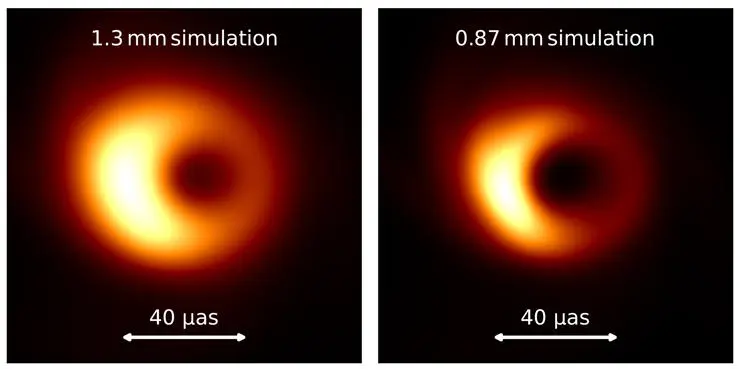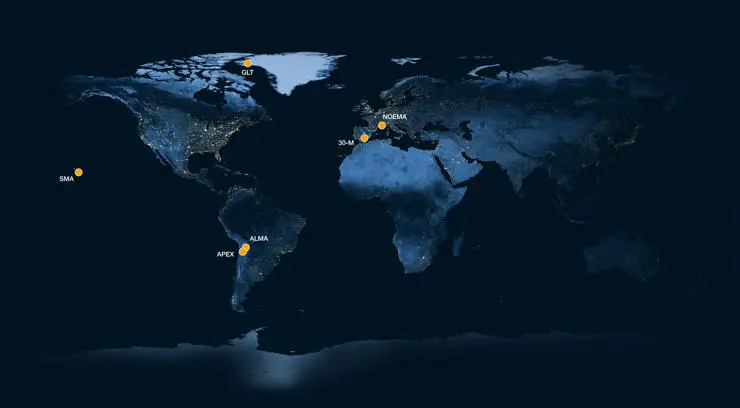The latest observations from the Event Horizon Telescope (EHT) Collaboration of astronomers have returned the highest-ever resolution images of a black hole from Earth.
The astronomers, including those from the University of Central Lancashire, in collaboration with the Atacama Large millimetre/submillimetre Array (ALMA), conducted test observations achieving the highest-resolution ever obtained from the surface of the Earth, by detecting light from the centres of distant galaxies at a frequency of around 345 GHz, equivalent to a wavelength of 0.87 mm.
The Collaboration, which has already imaged supermassive black holes at the hearts of M87 and Sgr A, estimates that with this breakthrough, they will be able to make black hole images 50% more detailed than was possible before and bring the region immediately outside the boundary of these cosmic beasts into sharper focus. The new detections were published today in The Astronomical Journal.
"It is the equivalent of having had an optical telescope that could previously only see red light, now suddenly being able to see yellow light as well. New features will become visible. This is an exciting time for the EHT."
— Professor Derek Ward Thompson
This is a huge step forwards for the Event Horizon Telescope” said Professor Derek Ward Thompson from the University of Central Lancashire’s Jeremiah Horrocks Institute and a key member of the Event Horizon Telescope collaboration.
“The factor of half as much again resolution will sharpen our focus on the area surrounding the black hole event horizon. Furthermore, by going to a new wavelength we will see different details.
“It is the equivalent of having had an optical telescope that could previously only see red light, now suddenly being able to see yellow light as well. New features will become visible. This is an exciting time for the EHT.”
The EHT creates a virtual Earth-sized telescope by linking together multiple radio dishes across the globe, using a technique called very-long-baseline interferometry (VLBI). To get higher-resolution images, astronomers have two options: increase the distance between radio dishes or observe at a shorter wavelength. Since the EHT was already the size of our planet, increasing the resolution of ground-based observations required expanding its wavelength range, and that’s what the Collaboration has now done.
"At 0.87mm, our images will be sharper and more detailed, which in turn will likely reveal new properties, both those that were previously predicted and maybe some that weren’t."
— Paper co-lead Alexander Raymond
“With the EHT, we saw the first images of black holes by detecting radio waves at the 1.3mm wavelength, but the bright ring we saw, formed by light bending in the black hole’s gravity still looked blurry because we were at the absolute limits of how sharp we could make the images,” said paper co-lead Alexander Raymond, previously a postdoctoral scholar at the Center for Astrophysics | Harvard & Smithsonian (CfA), and now at the Jet Propulsion Laboratory.
“At 0.87mm, our images will be sharper and more detailed, which in turn will likely reveal new properties, both those that were previously predicted and maybe some that weren’t.”
The new experiment used two small subarrays of the EHT—made up of ALMA and the Atacama Pathfinder EXperiment (APEX) in Chile, the IRAM 30-meter telescope in Spain, the NOrthern Extended Millimeter Array (NOEMA) in France, the Submillimeter Array (SMA) on Mauna Kea in Hawaii, and the Greenland Telescope—to make measurements with resolution as fine as 19 microarcseconds.
At .87 mm with the full EHT, scientists could see details as fine as 13 microarcseconds, much like observing a bottle cap on the Moon from Earth. This amounts to a 50% increase in resolution over what is currently possible. Importantly, EHT scientists are confident that these improvements will help to refine the study of black holes and unlock their many secrets.
"This new ‘colour vision’ allows us to tease apart the effects of Einstein’s gravity from the hot gas and magnetic fields that feed the black holes and launch powerful jets that stream over galactic distances."
— Paper co-lead Sheperd “Shep” Doeleman

Paper co-lead Sheperd “Shep” Doeleman, an astrophysicist at the CfA, and the Founding Director of the EHT said of the major breakthrough: “Consider the burst of extra detail you get going from black and white photos to color. This new ‘colour vision’ allows us to tease apart the effects of Einstein’s gravity from the hot gas and magnetic fields that feed the black holes and launch powerful jets that stream over galactic distances.”
With this in mind, he added that the Collaboration is excited to reimage M87* and Sgr A* at both 1.3 mm and .87 mm, and move from detecting black hole ‘shadows’ to more precisely measuring their sizes and shapes, which can help to estimate a black hole’s spin and orientation on the sky.
This is the first time the VLBI technique has been successfully used at a wavelength of 0.87 mm. While the ability to observe the night sky at 0.87 mm existed before the new detections, using the VLBI technique at this wavelength has long presented challenges that took time and technological advances to overcome. For example, water vapor in the atmosphere absorbs waves at 0.87 mm, much more than at 1.3 mm, making it more difficult for radio telescopes to receive signals from black holes at the shorter wavelength. The key was to improve the sensitivity of the EHT, which the researchers did by increasing the bandwidth of the instrumentation and waiting for good weather at all sites.
This achievement also provides another steppingstone on the path to creating high-fidelity movies of the event horizon environment surrounding black holes, which will rely on upgrades to the existing global array. The planned next-generation EHT (ngEHT) project will add new antennas to the EHT in optimized geographical locations and enhance existing stations by upgrading them all to work at multiple wavelengths between 3 mm and 0.87 mm at the same time. As a result of these and other upgrades, the global array is expected to increase the amount of sharp, clear data EHT has for imaging by a factor of 10, enabling scientists to not only produce more detailed and sensitive images, but movies starring these violent cosmic beasts.


